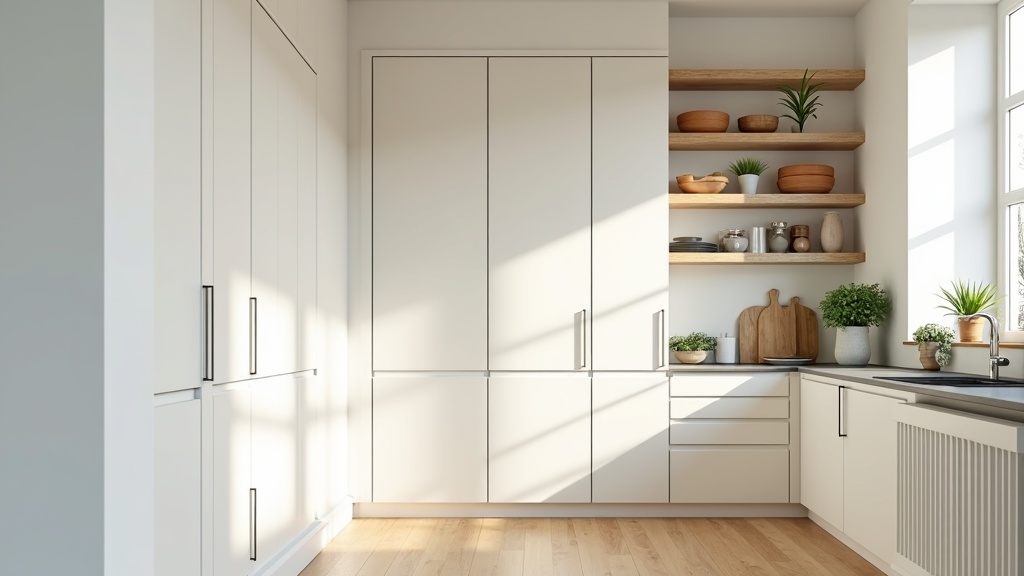Good lighting can completely change how cabinet spaces look and feel. Whether you’re working with kitchen cabinets, builtin storage, or display units, the right lighting isn’t just about being able to see what’s inside. It’s about taking your space up a notch, creating a mood, and turning ordinary cabinets into eye-catching features. If you’re new to the idea, figuring out your lighting options can seem a little tricky at first. Here, I’ll walk you through how you can use lighting to make cabinet spaces more functional and visually interesting.

Why Lighting Makes a Difference in Cabinet Spaces
Cabinet lighting isn’t just a popular upgrade. It can make a practical impact. Good lighting in cabinets helps you find items quickly, cuts down on eye strain, and helps keep things organized. In kitchens, for instance, well-lit cabinets make prepping food easier and safer. When used thoughtfully, lighting adds an extra layer of style and shines a light on decorative elements.
A lot of builders used to skip cabinet lighting to save money, but as LED technology has improved and prices have come down, more people are realizing how much even simple lighting can do. Cabinet lighting blends function and style, helping your storage pull double duty. For anyone trying to design a kitchen that feels new or customize a living space, it’s a detail worth checking out.
Lighting has also shifted to become more energy efficient. LEDs, in particular, have made low-heat, long-lasting, and super customizable cabinet lighting easier than ever. You don’t have to worry about bulbs getting hot or needing to be swapped out all the time.
Lighting To Enhance Cabinet Spaces
Types of Cabinet Lighting to Consider

With everything from strip lights to puck lights on the market, picking the right type can feel overwhelming. Each type has its strong points depending on the look and function you’re after. Here’s a rundown:
- Under Cabinet Strip Lights: These LED strips are popular for kitchens and workspaces. They offer even, wide coverage and are super easy to tuck under uppers or shelves.
- Puck Lights: Small, round fixtures that can be mounted on cabinet ceilings or walls. They produce a focused, downward pool of light, perfect for highlighting specific spots or display items.
- In Cabinet Linear Bars: Longer bar fixtures fit nicely inside tall cabinets or wardrobe units, lighting bigger spaces evenly.
- Toe Kick Lighting: Installed near the base of cabinets, this gives a soft glow along the floor, handy for night lighting or an upscale feel in kitchens and baths.
- Recessed Mini Lights: These blend right into the cabinet for a sleek, minimalist look, often used in highend kitchens or custom builtins.
No matter which type you pick, look for options that are easy to install and maintain. A lot of newer kits are plug-and-play, needing little more than some adhesive and a nearby outlet.
In some cases, designers mix a few different lighting types to bring in both function and style. For example, under cabinet strips can give you great indirect task lighting, while puck lights may work better if you want pools of light to shine a light on decorative pieces or favorite dishes. Toe kick strips can work well as nightlights, especially in kids’ rooms, or add a subtle highlight to a modern kitchen.
Step by Step Guide to Adding Lighting to Cabinet Spaces
If you’re handy, adding lighting to cabinet spaces can be a simple weekend project. Here’s how to get started:
- Plan Your Layout: Decide which cabinets would benefit most from added lighting. Under cabinet strips work well for task lighting, while interior puck lights or bars are great for accent or display.
- Choose Power Source: You can choose hardwired fixtures for a seamless look or opt for batterypowered/plugin versions for easier DIY installs. Hardwiring tends to be more permanent, but plugin versions are easier to update down the road.
- Pick Your Color Temperature: LED lights come in warm, neutral, and cool tones. Warm white (2700-3000K) is cozy, while cool white (4000K+) looks brighter and more clinical. For kitchen work, a neutral white makes colors pop but still feels homey.
- Install Fixtures: Carefully mount the chosen fixtures following the manufacturer’s instructions. With adhesive LED strips, just peel and stick. For puck or linear bars, you’ll likely need a drill or screwdriver but nothing major.
- Test and Tidy Up: Once installed, doublecheck for even lighting and hide any cords or wires as neatly as possible. Cord clips or channels can keep things looking clean and uncluttered.
Setting up a smart switch or motion sensor adds a little something extra, making sure the lights come on only when you need them. That’s pretty handy for pantries, linen closets, or bathroom vanities.
Don’t forget to sketch out your lighting plans on paper before you start drilling or sticking lights everywhere. Visualizing your layout helps prevent mistakes and ensures you get the effect you want. If you’re aiming for an extra tidy vibe, route cords behind trim, under shelf lips, or along the back edge of the cabinet so they’re out of sight.
Common Challenges and How to Handle Them

Adding lighting to cabinets isn’t complicated, but there are a few snags people run into. Knowing what to expect helps the project go smoothly from the start:
- Dealing with Power Sources: Sometimes the nearest outlet is in an awkward spot, or hardwiring isn’t budget-friendly. In this case, batterypowered LED bars or rechargeable strips are a good workaround. Some even have magnets so you can move them as needed.
- Hiding Cords: No one wants a jumble of wires all over their kitchen or closet. Self-adhesive cable management channels and cord clips make a big difference in keeping everything tidy and out of sight.
- Even Light Coverage: Overlapping strips or using diffusers helps avoid bright spots and shadows, especially on shiny backsplash materials or glass cabinet doors.
- Retrofitting Old Cabinets: Older cabinetry might not have easy access for wires, but ultrathin LED strips slide into tight spots and give a custom look with very little effort.
Power Options in More Detail
Hardwiring is the most seamless in terms of looks, but not everyone wants to fish wires through walls. I’ve had good results using USB or batterypowered strips. These are easy to attach and don’t need an electrician. For renters or those looking for quick updates, these options work nicely without damaging cabinets.
Finding the Right Balance of Brightness
It’s tempting to go for the brightest option, but I’ve found that’s not always better. Too much light can be harsh and make a space look cold. Using dimmable strips or bulbs helps tweak the brightness as needed. Some cabinet lighting strips now come with a remote or app allowing you to adjust the intensity and color temperature on the fly.
Style Tips to Make Cabinet Lighting Pop

Beyond the basics, cabinet lighting is a great place to let some style shine. Here’s how I like to approach it for both looks and function:
- Accent Lighting: Install lights behind glass front cabinets or open shelving to show off pretty dishes, collectibles, or glassware. Using a warm light makes glass and metallics sparkle without being overpowering.
- Task Lighting: In the kitchen, under cabinet strips directly above the workspace make meal prep simpler. For bar or coffee station setups, a splash of extra light is functional and cozy at the same time.
- Layered Lighting: Combine cabinet lights with overhead fixtures and wall sconces for a builtin, designer look. Mixing types of lighting gives each area of a room its own vibe.
- Smart Lighting: Some LED strips and pucks connect to smart home systems, letting you schedule, dim, or change colors via your phone. This makes it easy to set the mood for a dinner party or movie night.
When updating my own kitchen, I added a dimmer to the under cabinet lights for those late night snack trips. It gives enough light to see what I’m doing without being too bright. It’s been a small upgrade that really makes a difference in my day-to-day routines.
For those who want extra flair, color changing LEDs are an incredibly fun way to switch things up for the holidays or parties. Ducking under a softly glowing toe kick in the middle of the night or showing off glassware under subtle accent lighting always brings a little joy to guests and family alike.
Real-World Applications of Cabinet Lighting
Cabinet lighting works beyond just homes. In retail, it’s used to highlight merchandise and encourage shoppers to look closer. For galleries, cabinet lighting puts the focus on smaller displays without harsh overhead glare. Even small businesses find under cabinet lighting smart for illuminating checkout counters or service areas.
- Kitchen Displays: Lighting used inside glass front or open shelves looks inviting and modern, especially in kitchen remodels where showing off new countertops is the goal.
- Closets and Wardrobes: LED bars inside closets make outfit picking much easier, especially in spaces without natural light. Motionsensor lights save energy and keep hands free.
- Entertainment Centers: Integrated lighting behind media cabinets and shelves can reduce eye strain and make movie night setups feel more special.
Even in garages and workspaces, well-placed cabinet or shelf lighting can mean you find your tools quickly and never fumble around in the dark. Museums and jewelry counters have also been making the most of directed cabinet lights for years, as focused lighting helps precious items stand out. In offices, display case lighting adds a professional touch and keeps awards or important items in focus. As LEDs continue to become more affordable and diverse, more settings—both residential and commercial—are adding smart cabinet lighting for ease and style.
Frequently Asked Questions
Here are some questions people often have about cabinet lighting jobs:
Question: Do I need an electrician to install cabinet lights?
Answer: Not necessarily. There are plenty of plugin or batterypowered lighting kits specifically made for DIY installs. Hardwiring is better for a permanent, seamless look and may need a pro, but a lot of options don’t require special skills.
Question: Is LED lighting safe for all cabinet materials?
Answer: LEDs don’t get hot the way traditional bulbs do, making them safe for wood, laminate, plastic, and more. Just make sure cords are routed away from moving parts like doors or sliding shelves.
Question: How do I hide cords when installing cabinet lighting?
Answer: Cord management channels, adhesive cable clips, and even paintable cord covers keep things looking clean. Running cords along cabinet edges or behind trim also helps them disappear.
Making the Most of Your Cabinet Lighting
Bringing added lighting to your cabinets doesn’t have to mean a big renovation. Even a few simple upgrades can give a boost to both looks and practicality. Whether you’re showing off your best dishes, making it easier to find that box of pasta, or creating a cozy vibe for your next get-together, cabinet lighting can make a surprising difference. It’s a small project with a big payoff for daily life and for adding a little personality to your space.

Happiness is finding the right tool, right when you need it!
